النماذج التشغيلية
يحدد تقرير حالة النقد في العالم التابع لشبكة CALP أنواعًا مختلفة من النماذج التشغيلية، بما في ذلك الاتحادات والتحالفات، وآليات تسليم النقد المشتركة، وتسليم الأموال من وكالة واحدة، وتكامل الأنظمة.
تعرّف شبكة CALP النموذج التشغيلي بأنه
.”الهيكل العام الذي تعمل من خلاله الوكالات بشكل مشترك … لتقديم برمجة النقد والقسائم … في الاستجابة والتحليل، وتصميم البرامج وتنفيذها.”
يوفر توسيع نطاق المساعدات النقدية والقسائم فرصًا لتغيير طريقة تقديم المساعدات الإنسانية. وله آثار على أدوار الوكالات المختلفة في مختلف النماذج التشغيلية، وإمكانية ربط النماذج بأنظمة الحماية الاجتماعية. كما سيؤثر على طبيعة الشراكات مع مقدمي الخدمات المالية والتكنولوجيا، وكيف تتفاعل النماذج المختلفة مع أشكال المساعدة الأخرى، بخلاف النقد.
الأولويات الحالية
منذ أواخر عام 2016، تعمل شبكة CALP على تنسيق أجندة التعلم للمساعدة في الإجابة على هذه الأسئلة:
- ما هي النماذج التشغيلية المتاحة للوكالات التي تقدم المساعدات النقدية والقسائم؟
- كيف تعمل النماذج المختلفة على تحسين كفاءة وفعالية ومساءلة المساعدات النقدية والقسائم في سياقات مختلفة؟
- ما هي النماذج التشغيلية الأكثر ملاءمة وفي أي سياقات؟
ستستمر شبكة CALP في جمع ونشر قاعدة الأدلة للنماذج التشغيلية.
تعد شبكة CALP أيضًا شريكًا في اتحاد شبكة تنظيم مراقبة النقد وتقييمه والمساءلة والتعلم، بقيادة المجلس النرويجي للاجئين، وهو المسؤول عن الرصد والتقييم المستقلين للمساعدة النقدية متعددة الأغراض لبرنامج الأغذية العالمي في لبنان. وهذا يشمل البحث والتحليل فيما يتعلق بالقيمة مقابل المال والمساءلة في النموذج التشغيلي.
Featured content

Operational Models: Accountability to affected people
Webinar

MEAL in Emerging Operational Models
Webinar

CTP Operational Models Analytical Framework
Guidelines and Tools
The State of the World’s Cash Report launched by the CALP Network in February 2018 highlights trends in the uptake of various operational models for the delivery of cash at scale in humanitarian response. Current decision making on the choice between these various operational models is highly influenced by context, and by the policies and approaches of donor agencies. Decision making on...
Thematic lead
Latest

Understanding and Strengthening Informal Seed Markets
Report
Informal markets receive little attention from governments and researchers, despite their centrality to farmers’ seed security. This paper documents the importance of informal markets for supplying seed and restocking critical plant genetic resources in normal and stress periods. It analyses farmers’...

Comparing Cash and Food Transfers: a Cost-Benefit Analysis from Rural Malawi
Report
The Cash and Food for Livelihoods Pilot (CFLP) project was a cash and food-for-assets scheme implemented in southern Malawi over the eight months from October 2008 to May 2009, benefiting 11,100 households. CFLP was designed to prevent acute hunger and invest in disaster prevention and preparedness...
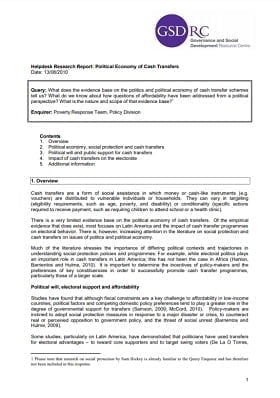
Helpdesk Research Report: Political Economy of Cash Transfers
Report
Cash transfers are a form of social assistance in which money or cash-like instruments (e.g. vouchers) are distributed to vulnerable individuals or households. They can vary in targeting (eligibility requirements, such as age, poverty, and disability) or conditionality (specific actions required to...
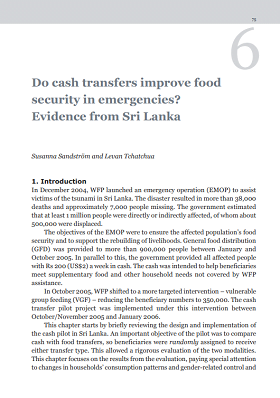
Do Cash Transfers Improve Food Security in Emergencies? Evidence from Sri Lanka
Case Study
In December 2004, WFP launched an emergency operation (EMOP) to assist victims of the tsunami in Sri Lanka. The disaster resulted in more than 38,000 deaths and approximately 7,000 people missing. The government estimated that at least 1 million people were directly or indirectly affected, of whom about...

Delivering money: Cash transfer mechanisms in emergencies
Report
This report documents lessons learned in cash transfer programming in emergencies, with a particular focus on the practicalities of how to deliver money to beneficiaries. It provides guidance for project managers needing to make choices about how to efficiently and effectively deliver cash, and explores...
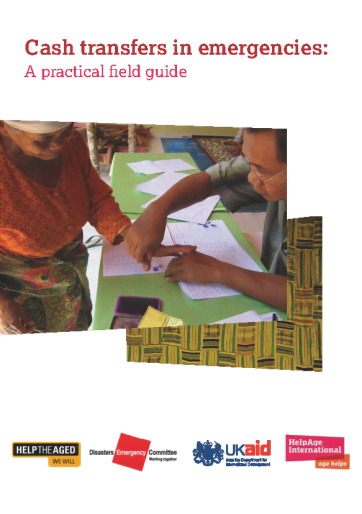
Cash transfers in emergencies: A practical field guide
Guidelines and Tools
A practical and user-friendly field guide for using cash to meet the needs of older people. This guide covers deciding if cash is appropriate, conducting initial assessments and market analysis, identifying beneficiaries and amounts, preparing the community and implementing cash transfers. The purpose of...

Guidelines for cash interventions in Somalia
Guidelines and Tools
These guidelines are intended for all agencies operating in Somalia to represent a common approach to cash transfer programming for food security and livelihood activities in Somalia. The guidelines outline the minimum acceptable standards for cash interventions and provide the justification for...

Cash grants in Upper Sindh flood response 2010
Case Study
This case study and paper summarises Oxfam’s experience with unconditional cash grants to 20,000 households in response to the flooding in Upper Sindh, Pakistan in 2010. It retrospectively documents the Oxfam project, emphasising issues relevant to a wide practitioner audience interested in experience...

Enterprise Recovery Following Natural Disasters
Report
Using data from surveys of enterprises in Sri Lanka after the December 2004 tsunami, the authors undertake a microeconomic study of the recovery of the private firms in a developing country following a major natural disaster. Disaster recovery in low-income countries is characterized by the...
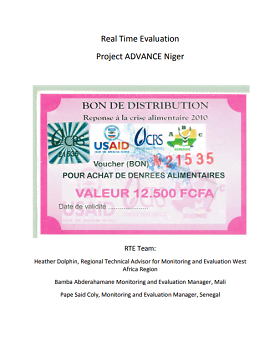
Real Time Evaluation: Project ADVANCE Niger, Final Report
Report
The 2009 agricultural season in Niger was marked by dramatic crop production deficits. The most recent drought in Niger has led to an escalation in the price of locally-produced staple grains in the region. While demand in local markets remains high, as is normal right before the lean season, many...
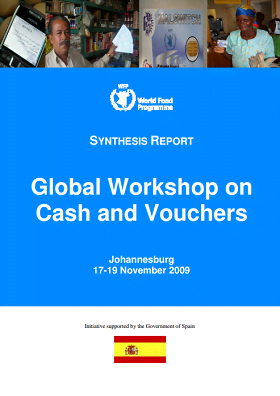
WFP Global Workshop on Cash and Vouchers
Report
This document provides a summary and synthesis of key outcomes and emerging priorities. It also provides a summary of the current status of voucher and cash programming in WFP. A discussion of key emerging cross-cutting issues follows. Strategic priorities for WFP voucher and cash programming and policy...

Cash Transfers in Post-conflict Contexts
Report
This ODI project briefing looks at the implementation for the design of cash programmes in post-conflict or fragile states, compared to those of peaceful and stable countries. It highlights examples from Sierra Leone and Nepal drawing lessons from existing programmes, examines the contribution to poverty...
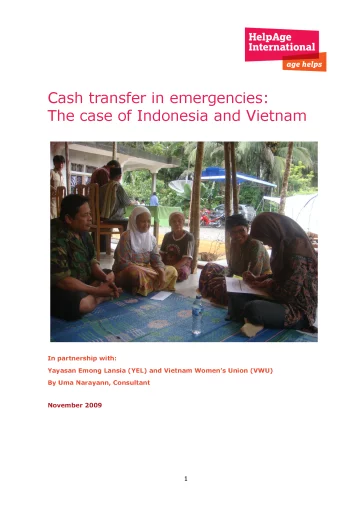
Cash Transfers in Emergencies: The case of Indonesia and Vietnam
Case Study
In October 2009, typhoon Ketsana brought heavy rains over Vietnam causing sudden and heavy flooding, which led to considerable loss of lives, shelters and livelihoods. Around the same time, an earthquake measuring 7.2 on the Richter scale struck the island of Sumatra in Indonesia causing massive loss of...
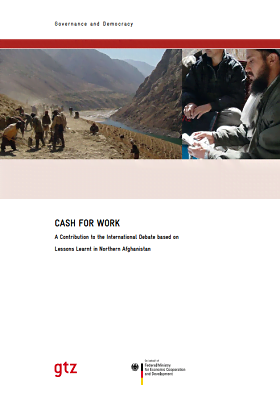
Cash For Work: A Contribution to the International Debate based on Lessons Learnt in Northern Afghanistan
Case Study
The purpose of this study was to document learning from BMZ finance cash for work (CFW) projects implemented by GTZ in Afghanistan as a contribution to international debates about cash transfer approaches. The operations of the GTZ CFW scheme in Northern Afghanistan are financed by the German Federal...
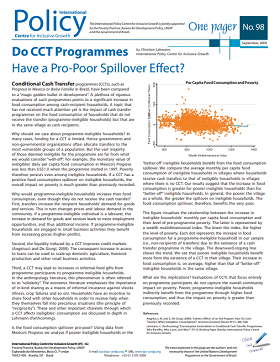
Do CCT programmes have a pro-poor spillover effect?
Report
This one pager looks at the indirect impact of cash transfer programmes on the food consumption of households which have not received a transfer, but are within the same village as households which have. The paper looks at why this occurs, using evidence from Mexico to show that this phenomena in indeed...
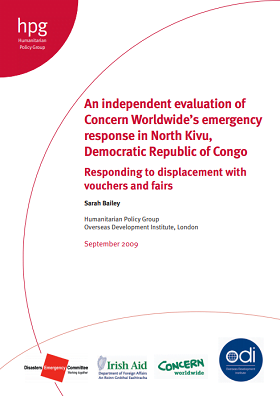
An independent evaluation of Concern Worldwide’s emergency response in North Kivu, Democratic Republic of Congo: Responding to displacement with vouchers and fairs
Case Study
In late 2008, escalated fighting among rebels and the Congolese Armed Forces (FARCD) provoked renewed and widespread displacement in North Kivu province, Democratic Republic of Congo (DRC). In response to the unfolding crisis, Concern Worldwide implemented the project Emergency Assistance to Newly...

Lessons Learned from the Post Election Violence Early Recovery Programme in Kenya 2008-2009
Case Study
The Kenya Post Election Violence (PEV) Early Recovery Programme was an ECHO-supported response by six international NGOs to the ethnic and political violence which severely affected livelihoods in the Rift Valley, Nyanza and Central Provinces after the disputed national elections in late December 2007....

Fresh food vouchers for refugees in Kenya
Report
Read the report here This article in Field Exchange magazine outlines an intervention by ACF in Dadaab to improve the nutritional intake and dietary diversity of the refugee population of Dadaab, Kenya, through a complementary food voucher scheme targeted at malnourished children.
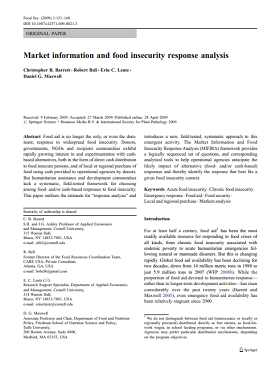
Market Information and Food Insecurity Response Analysis (MIFIRA)
Report
This paper outlines the importance and rationale for agencies to undertake a “response analysis” before choosing an appropriate programme delivery mechanism to a humanitarian situation. The Market Information and Food Insecurity Response Analysis (MIFIRA) framework is introduced. This provides a...

The Role of Cash Transfers in Post-Conflict Nepal
Report
Nepal is in the midst of a transformational process: the end of the eleven year conflict in 2006 has given way to the end of the monarchy, the development of a new Constitution, and a democratically elected government which emphasises an inclusive Nepali society. However, the peace process has been slow,...


